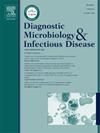Identification of the causative organisms in 17 cases of infected abdominal aortic aneurysms using ribosomal RNA gene sequencing analysis and genetic study on 10 cases of Helicobacter cinaedi
IF 1.8
4区 医学
Q3 INFECTIOUS DISEASES
Diagnostic microbiology and infectious disease
Pub Date : 2025-07-21
DOI:10.1016/j.diagmicrobio.2025.117019
引用次数: 0
Abstract
Infected abdominal aortic aneurysm (IAAA) is a life-threatening condition, often complicated by a high rate of culture-negative cases, which hampers appropriate antimicrobial selection. This study investigated the causative organisms in 17 patients who underwent surgery for IAAA at two institutions in Japan. Pathogens were identified through blood and tissue cultures, ribosomal RNA gene sequencing, and histopathological examination. In cases where Helicobacter cinaedi was detected, multilocus sequence typing (MLST) and genetic analyses for resistance to β-lactams, macrolides, and quinolones were conducted. Of the 17 cases, 11 (64.7%) were culture-negative, and H. cinaedi was identified in 8 (72.7%) of these through rRNA gene analysis. Including 2 culture-positive cases, H. cinaedi was found in 10 cases (58.8%) overall. All H. cinaedi cases harbored genetic mutations associated with macrolide resistance and amino acid substitutions linked to quinolone resistance, while no mutations related to β-lactam resistance were detected. These findings indicate that H. cinaedi is a predominant pathogen in culture-negative IAAA and suggest that β-lactam antibiotics are appropriate for treatment, whereas macrolides and quinolones should be avoided.
应用核糖体RNA基因测序分析鉴定17例感染腹主动脉瘤的病原菌,并对10例中国螺杆菌进行遗传分析
感染腹主动脉瘤(IAAA)是一种危及生命的疾病,通常因培养阴性病例的高比例而复杂化,这妨碍了适当的抗菌药物选择。本研究调查了在日本两家机构接受IAAA手术的17例患者的致病微生物。病原体通过血液和组织培养、核糖体RNA基因测序和组织病理学检查进行鉴定。在检测到中国螺杆菌的病例中,进行了多位点序列分型(MLST)和对β-内酰胺类、大环内酯类和喹诺酮类耐药的遗传分析。17例患者中11例(64.7%)培养阴性,其中8例(72.7%)通过rRNA基因分析检出中华螺杆菌。其中2例培养阳性,10例(58.8%)检出中华嗜血杆菌。所有病例都携带与大环内酯类药物耐药相关的基因突变和与喹诺酮类药物耐药相关的氨基酸取代,而未检测到与β-内酰胺耐药相关的突变。这些结果表明,H. cinaedi是培养阴性IAAA的主要病原体,并提示β-内酰胺类抗生素适合治疗,而大环内酯类和喹诺酮类药物应避免使用。
本文章由计算机程序翻译,如有差异,请以英文原文为准。
求助全文
约1分钟内获得全文
求助全文
来源期刊
CiteScore
5.30
自引率
3.40%
发文量
149
审稿时长
56 days
期刊介绍:
Diagnostic Microbiology and Infectious Disease keeps you informed of the latest developments in clinical microbiology and the diagnosis and treatment of infectious diseases. Packed with rigorously peer-reviewed articles and studies in bacteriology, immunology, immunoserology, infectious diseases, mycology, parasitology, and virology, the journal examines new procedures, unusual cases, controversial issues, and important new literature. Diagnostic Microbiology and Infectious Disease distinguished independent editorial board, consisting of experts from many medical specialties, ensures you extensive and authoritative coverage.

 求助内容:
求助内容: 应助结果提醒方式:
应助结果提醒方式:


